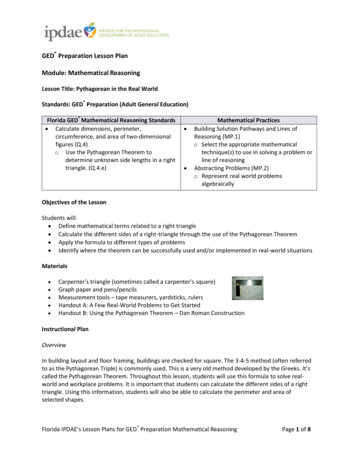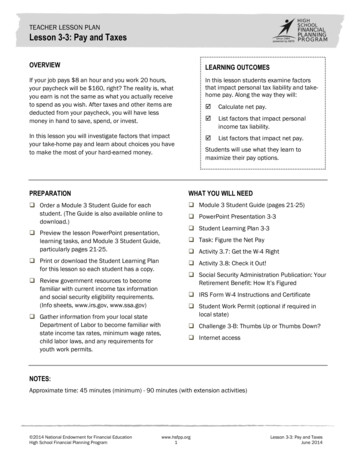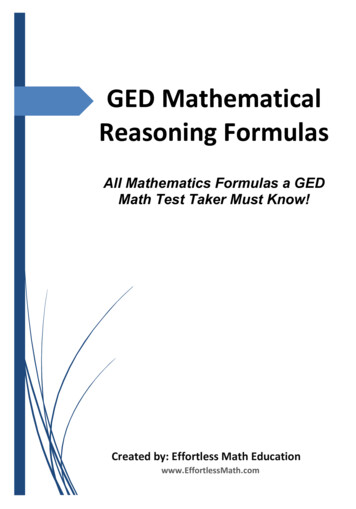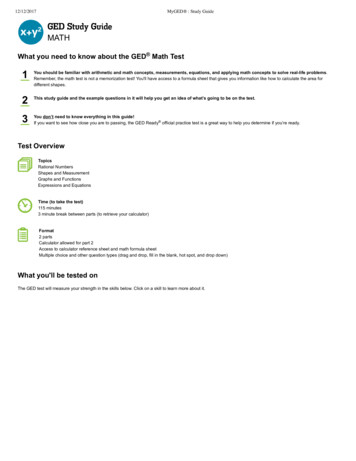
Transcription
GED Preparation Lesson PlanModule: Mathematical ReasoningLesson Title: Pythagorean in the Real WorldStandards: GED Preparation (Adult General Education)Florida GED Mathematical Reasoning Standards Calculate dimensions, perimeter,circumference, and area of two-dimensionalfigures (Q.4)o Use the Pythagorean Theorem todetermine unknown side lengths in a righttriangle. (Q.4.e) Mathematical PracticesBuilding Solution Pathways and Lines ofReasoning (MP.1)o Select the appropriate mathematicaltechnique(s) to use in solving a problem orline of reasoningAbstracting Problems (MP.2)o Represent real world problemsalgebraicallyObjectives of the LessonStudents will: Define mathematical terms related to a right triangle Calculate the different sides of a right-triangle through the use of the Pythagorean Theorem Apply the formula to different types of problems Identify where the theorem can be successfully used and/or implemented in real-world situationsMaterials Carpenter’s triangle (sometimes called a carpenter’s square)Graph paper and pens/pencilsMeasurement tools – tape measurers, yardsticks, rulersHandout A: A Few Real-World Problems to Get StartedHandout B: Using the Pythagorean Theorem – Dan Roman ConstructionInstructional PlanOverviewIn building layout and floor framing, buildings are checked for square. The 3-4-5 method (often referredto as the Pythagorean Triple) is commonly used. This is a very old method developed by the Greeks. It’scalled the Pythagorean Theorem. Throughout this lesson, students will use this formula to solve realworld and workplace problems. It is important that students can calculate the different sides of a righttriangle. Using this information, students will also be able to calculate the perimeter and area ofselected shapes.Florida IPDAE’s Lesson Plans for GED Preparation Mathematical ReasoningPage 1 of 8
ProcessIntroduce the lesson by asking students the following questions: Why is a 48-inch television not four feet wide? Why does a 7-inch tablet seem so small?Discuss that when you are given the size of a screen, you are being provided with the length of thediagonal, not the width of the screen. Share that in today’s lesson, they will be using a math formulathat is used in many different real-world situations.Have students discuss how they use math formulas in their daily lives. Explain that there are manydifferent types of formulas that people use to solve real-life problems. Ask the students whether theyhave ever used a formula for a triangular shape. Students who have made home renovations or whowork in carpentry may respond that they have to work with triangles. Have them explain what they doand why it is important to them.Have students brainstorm situations where right triangles occur. Examples may include: Straight line distance between locations on roads that are perpendicular to one another Length of a ramp when you know the height and linear distance it covers A ladder against the side of a house Length of the ramp for a moving truckShow students a carpenter’s triangle or a picture of a carpenter’s triangle if one is not readily available.Share with students that this tool is used by carpenters to ensure that their walls are “square.” Discusswhat is meant by a square wall. If a carpenter’s triangle is available, have students use it to see if thewalls in the classroom are square. They may also want to check to see if a leg on a desk or table issquare with the floor. Give them time to explore common objects in the room. If the students discoverobjects that are not square, ask them what they think is wrong with the object? They should see that theangle is not a right angle (90 angle).Have students identify each part of a right triangle and define the following vocabulary terms: Leg Hypotenuse Right angle Side a Side b Side c Vertex Perimeter AreaExplain that right triangles have special properties. One special property is that the square of the lengthof the hypotenuse of a right triangle is the sum of the squares of the lengths of the two sides. This isusually expressed as a2 b2 c2. Integer triples, which satisfy this equation, are called Pythagoreantriples. The most well-known examples are (3, 4, 5) and (5, 12, 13).Florida IPDAE’s Lesson Plans for GED Preparation Mathematical ReasoningPage 2 of 8
Write the formula a2 b2 c2 on the board. Have students discuss how this theorem can be used tosolve real-world problems. Problems obtained from the Internet or from Handout A: A Few Real-WorldProblems to Get Started can be used for practice and assessment. Have students use the formula tocompute the answer for the triangle they used in the first problem. The sides were 3 units by 4 units.a2 b2 c232 42 c29 16 25square root of 25 5 (the length of the hypotenuse)Have students use graph paper to draw a variety of right triangles with different dimensions. Have themuse the formula to determine the hypotenuse of each triangle. After calculating, have them measure tocheck for accuracy.Teach students how to find one leg of a right triangle if the other leg and hypotenuse are provided.Draw and label the following triangle on the board or overhead and have students determine how tofind the value of b.a2 b2 c262 b2 10236 b2 1006b2 100 – 36b2 64bb 8Provide students with practice questions on determining the sides of a triangle. Sample problems areincluded on Handout A: A Few Real-World Problems to Get Started.10Once students have proficiency in determining the different sides of a triangle, show them how todetermine the perimeter and area of right triangles. The following is an example to use.Joseph has a piece of poster board that measures 12 inches by 16 inches. He cuts the poster board in halfdiagonally and wants to know the perimeter of one piece. What is the perimeter of Joseph’s board?Show students how to find the length of the missing side (the hypotenuse).a2 b2 c2122 162 c2144 256 c2c2 400 c2 400c 20The missing side is 20 inches. Now, add the three sides together to get the perimeter - 12 16 20 48inches.Show students how to find the area of a right triangle by using the previous dimensions and the formula:A ½ bh.A ½ (12 x 16) 96 square inchesFlorida IPDAE’s Lesson Plans for GED Preparation Mathematical ReasoningPage 3 of 8
Divide the class into small groups and provide them with Handout B: Using the Pythagorean Theorem –Dan Roman Construction. Have the students solve the workplace problem and share their findings withthe class.Have students brainstorm additional examples of how the formula for the Pythagorean Theorem isused. (Examples: A builder could use the Pythagorean Theorem to calculate how many shingles areneeded for a roof based on its’ slope. A baseball fan could use the theorem to find out how far a ballwould have to be thrown from first to third base. A person could figure how tall a ladder would need tobe to reach a second story.)Sample Debriefing Questions What is the relationship among the lengths of the sides of a right triangle?What is the Pythagorean Theorem and when does it apply?How do you use the Pythagorean Theorem to find the length of the hypotenuse of a righttriangle?How do you use the Pythagorean Theorem to find the length of the legs of a right triangle?How does the knowledge of how to use right triangles and the Pythagorean Theorem enable thedesign and construction of such structures as a properly pitched roof, handicap ramps to meetcode, structurally stable bridges, and roads?Modifications for Different LevelsTo modify instruction, provide students with a list of the vocabulary words and real-world examples. Usephysical examples of the theorem so that students can determine the “why” of the PythagoreanTheorem. Spend time reinforcing the Pythagorean Triples. You may wish to have students onlydetermine the hypotenuse at this time.For example: have students identify the different parts of a triangle and then measure the: Screens of their phone, computer screens, etc. Classroom square tables and other items in the room with right anglesAssessments/ExtensionsThroughout the lesson, monitor that students are able to construct the figures correctly and verbalizetheir findings. Students should be able to apply the Pythagorean Theorem to different types of realworld problems. Provide students with GED -type questions that require them to apply the formula.Example:You are a new employee with the Pythagorean Construction Company. Your boss has given you a pieceof plywood with dimensions that are 1.2 m x 2.4 m. You would like to be able to pass the plywoodthrough a window that is 1 m by ¾ m. You really don’t want to tell your new boss that you can’t do whathe is asking. Can you pass the plywood through the window? Why or why not? Explain your reasoning.Answer: Yes, it will just fit as long as it is not too thick. The diagonal of the window is 1.25 m.Some students may see that ¾:1:1.25 is a Pythagorean Triple.Florida IPDAE’s Lesson Plans for GED Preparation Mathematical ReasoningPage 4 of 8
Handout AA Few Real-World Problems to Get StartedFinding the Hypotenuse1. Two friends are meeting at the park. Lisette is already at the park, but her friend Ed needs to getthere taking the shortest path possible. Ed has two ways he can go. He can follow the roads gettingto the park - first heading south 3 miles, then heading west four miles. The total distance coveredfollowing the roads will be 7 miles. The other way he can get there is by cutting through some openfields and walking directly to the park. How far would he walk cutting through the open fields?2. Painters use ladders to paint on high buildings and often use the Pythagorean Theorem to completetheir work. A painter needs to determine how tall a ladder needs to be in order to safely place thebase away from the wall so it won't tip over. A painter has to paint a wall which is about 3 m high.The painter has to put the base of the ladder 2 m away from the wall to ensure it won't tip. Whatwill be the length of the ladder required by the painter to complete his work?3. Mr. Ortez saw an advertisement for a television in the newspaper where it is mentioned that theT.V. is 16 inches high and 14 inches wide. Calculate the diagonal length of its screen for Mr. Ortez.4. Computer screens are measured the same way television screens, smart phone screens, and tabletscreens are – diagonally. Arturo wants to purchase a laptop. He measures the laptop screen andnotes that it is 12 x 9 inches in size. However, it is not advertised as a 12 or 9 inch laptop. Thesalesperson states that the actual size of the screen is based on the diagonal, not the sidemeasurement. What size computer screen is Arturo purchasing?5. You’re locked out of your house and the only open window is on the second floor, 25 feet above theground. You need to borrow a ladder from one of your neighbors. There is a bush along the edge ofthe house, so you’ll have to place the ladder 10 feet from the house. What length of ladder do youneed to reach the window?6. You’ve just picked up a ground ball at first base, and you see the other team’s player runningtowards third base. How far do you have to throw the ball to get it from first base to third base andthrow the runner out? Hint: A baseball diamond is actually a square, with each side being 90 feetand right angles at each base.Finding the Side of a Triangle1. Mr. Simone wants to purchase a suitcase. The shopkeeper tells Mr. Simone that he has a 30-inchsuitcase available at present and the height of the suitcase is 18 inches. Calculate the actuallength of the suitcase.2. A sailboat has a large sail in the shape of a right triangle. The longest edge of the sail measures17 yards, and the bottom edge of the sail measures is 8 yards. How tall is the sail?3. The Smith’s bought a 6 foot square sheet of plywood as a base for their electric train. Will theplywood fit in the back of their van? The opening of the van is 44 inches high and 60 incheswide?4. In a computer catalog, a computer monitor is listed as being 19 inches. This distance is thediagonal distance across the screen. If the screen measures 10 inches in height, what is theactual width of the screen to the nearest tenth of an inch?Florida IPDAE’s Lesson Plans for GED Preparation Mathematical ReasoningPage 5 of 8
Answers: A Few Real-World Problems to Get StartedFinding the Hypotenuse1.2.3.4.5.6.5 miles - Walking through the field will be 2 miles shorter than walking along the roads.5.3 m. – the painter will need a ladder about 5 meters high.Approximately 21 inches15 inch computerA 27 foot ladderYou need to throw the ball 127.3 feet to get it from first base to third base.Finding the Side of a Triangle1. 24 inches2. 15 yards3. The diagonal is the longest length, so if the plywood is to fit, the diagonal must be greater than 6feet. The diagonal is 6.2 feet, so the plywood would fit.4. 16.2 inchesFlorida IPDAE’s Lesson Plans for GED Preparation Mathematical ReasoningPage 6 of 8
Handout BUsing the Pythagorean Theorem – Dan Roman ConstructionMicron Workplace Math. Retrieved from the World Wide Web rpenter%20(1).pdfOccupation: Framing Contractor/CarpenterProblem:A customer would like a bonus room to be added to an existing home. The new room is to be 26' x 24'with an 8' ceiling and a 2' roof overhang. The ridge of the roof is to be centered over the 24 foot walland 5 feet above the top of the wall of the bonus room.Assuming the builder uses standard 4' x 8' plywood sheets, determine the following:1. How many plywood sheets will be needed to cover the walls of the bonus room (not accountingfor doors or windows)?2. How many plywood sheets will be necessary to cover the roof over the bonus room?Florida IPDAE’s Lesson Plans for GED Preparation Mathematical ReasoningPage 7 of 8
Solution – Using the Pythagorean Theorem – Dan Roman Construction1.To find out how many sheets will be necessary for the four walls, divide the area of the walls by the areaof plywood sheet (not allowing for doors or windows).26’ x 8’ (2 walls) 24’ x 8’ (2 walls)4’ x 8’ plywood sheet(2 x 208 sq. ft.) (2 x 192 sq. ft.) / 32 sq. ft. 416 sq. ft. 384 sq. ft. / 32 sq. ft. 800 sq. ft. / 32 sq. ft. 25 sheets of plywood for the walls2.To find out how many sheets will be necessary for the roof, divide the total area of the roof (two equalsides) by the area of a plywood sheet. The ridge of the roof is 26 feet and the overhang is 2 feet. Theheight of the roof is 5 feet. Find the area of each side of the roof by using the Pythagorean Theorem to222calculate the length from the ridge to the edge (a b c ), adding the overhang, and multiplying thetotal length by the width (ridge).225 12 C2225 x 144 CC 13 ft. 52Roof area: (2' 13') x 26' 390 sq. ft. x 2 (both sides) 780 sq. ft.Now divide by the plywood sheet dimension:780 sq. ft. /2’ x 8’ sheets 24.375 or 25 sheets of plywood for the roofFlorida IPDAE’s Lesson Plans for GED Preparation Mathematical ReasoningPage 8 of 8
Florida IPDAE’s Lesson Plans for GED Preparation Mathematical Reasoning Page 3 of 8 Write the formula a 2 b 2 c on the board. Have students discuss how this theorem can be used to solve real-world problems. Problems obtained from the Internet or from Handout A: A Few Real-World Problem











